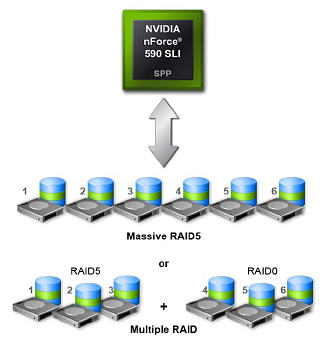nForce 500: nForce4 on Steroids?
by Gary Key & Wesley Fink on May 24, 2006 8:00 AM EST- Posted in
- CPUs
Improved Feature: MediaShield
While the networking side has undergone an extensive makeover, the storage side of the nForce500 has been fine tuned. The nForce 590/570 series now offers three separate SATA controllers each with integrated dual PHYs that are capable of operating at 1.5Gb/s or 3.0Gb/s speeds. This results in six Serial ATA devices being available for the user instead of four as in the nForce4, Intel ICH7, or ATI SB600. These devices can be configured in RAID 0, 1, 0+1, and 5 arrays. There is no support for RAID 10.
Considering the support for six drives, it is now possible to run a massive RAID 5 drive consisting of a pair of three-drive RAID 5 arrays together, or running multiple combinations of RAID technology together. NVIDIA also supports the shared spare (or dedicated spare) technique in MediaShield. The spare disk feature, available with MediaShield RAID 5, offers protection with a dedicated spare drive that can take over for a failed disk until the repair is completed. However, the performance results during our RAID testing found no measurable differences between the nForce4 and nForce 500 storage systems. In fact, the less than stellar write performance of the nForce4 in RAID 5 continues in the "new" chipset.
NVIDIA will be introducing a new twist to improve their SATA controller performance by offering profiles for specific hard drive models. Since each hard drive has unique performance characteristics, NVIDIA will be matching the capabilities of their controller logic to each drive's particular strengths. So far, Western Digital's 150GB Raptor has the only profile loaded, but there are plans to profile additional performance oriented drives that are popular in the market. The nForce4 family will also benefit from these profiles through driver updates, but users are not able to configure or modify individual drive profiles. In our testing with dual WD1500 Raptors we noticed benchmark results that were on average about 1% to 2% better in our IPEAK tests while the synthetic tests realized a 3% gain in some areas.
While NVIDIA has implemented six native SATA ports, they reduced the available PATA ports to one. This matches the Intel ICH7 and ATI SB600, but the reduced PATA ports will not be seen as an improvement to many users. Considering the Optical drive manufacturers have been very slow to implement SATA in their drives, this decrease in port count could affect those users who have multiple optical drives for audio/video content creation and manipulation. However, with the major core logic suppliers basically on the path of phasing out PATA devices this move by all the chipset manufacturers might spur the optical drive manufacturers to a quicker SATA transition.










64 Comments
View All Comments
Olaf van der Spek - Wednesday, May 24, 2006 - link
<quote>These devices can be configured in RAID 0, 1, 0+1, and 5 arrays. There is no support for RAID 10.</quote>That's probably because there's effectively no difference between 1+0 and 0+1 on a good controller.
Olaf van der Spek - Wednesday, May 24, 2006 - link
Doesn't this require support from the modem/router too?
The delay (usually) happens in the modem and not in the network card.
Zoomer - Saturday, May 27, 2006 - link
No, because you make the bottleneck your network card, instead of the modem. :)There will be a slight loss of throughput. Read some QoS articles. lartc.org is also a good resource. I bet it's the same principle. ;)
Trisped - Wednesday, May 24, 2006 - link
<quote>Multiple computers can to be connected simultaneously </quote>http://www.anandtech.com/cpuchipsets/showdoc.aspx?...">http://www.anandtech.com/cpuchipsets/showdoc.aspx?...
take out the "to"
Gary Key - Wednesday, May 24, 2006 - link
Thanks, it is corrected.....Googer - Wednesday, May 24, 2006 - link
When benchmarking core logic it's should be a high priority to measure I/O performance, since that is the primary job of any AMD Chipset.Where are the HDD, Network, Audio, and R.A.I.D. benchmarks?
Gary Key - Wednesday, May 24, 2006 - link
I answered above but we will have full benchmarks in the actual motherboard articles. Our efforts in the first three days was to prove out the platform and features that were added or changed (still doing it, feels weird to be up almost 72 hours). In answer to your question-
Foxconn Board
Network-
Throughput - 942 Gb/s
CPU utilization - 14.37% (with TCP/IP offload engine on), near 30% off.
HDD/RAID
No real difference compared to nF4 as we stated. The numbers are within 1% of each other. The interesting numbers will be in our ATI SB600 comparison.
Audio-
Dependent on the codec utilized in each motherboard, the RealTek ALC883 used in most of them have the same numbers as the nF4 boards. The only difference is the new 1.37 driver set we used. It will be interesting in the comparison as Asus went back to ADI for HDA.
Pirks - Wednesday, May 24, 2006 - link
That's why AT is my favorite review site - 'cause you're really crazy bunch :-) Just don't ruin yourself completely, we need you!Gary Key - Wednesday, May 24, 2006 - link
The ending should read NF4 Intel or ATI/Uli AMD boards. Where is that edit function? Hit enter too soon. :)Gary Key - Wednesday, May 24, 2006 - link
They will be in our roundup comparison and ATI AM2 articles.